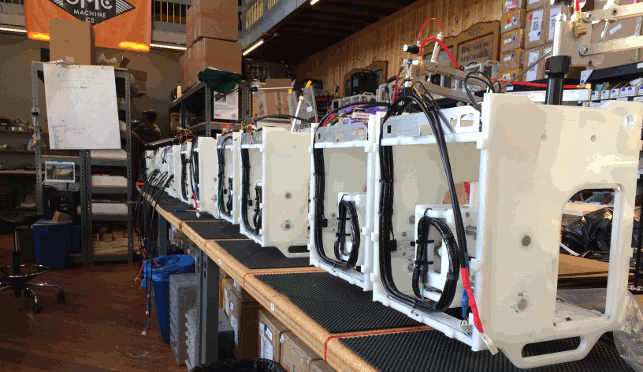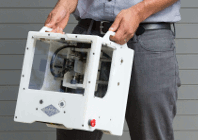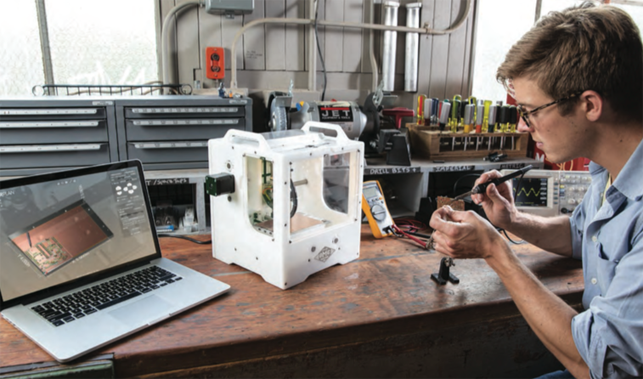
The Othermill desktop CNC milling machine is easy to use — unpack, insert the collet, install Otherplan on your computer or laptop,and make your first project
The Schoenstein Organ Factory in San Francisco’s Mission District has a long history of manufacturing. In the early 1900s it saw pipe organs leave through its doors, and today it serves as the office, factory and showroom for a completely different product — a desktop CNC machine called the Othermill.
Alongside the hardware, Other Machine Co. (OMC) has also designed easy-to-use software called Otherplan, which guides users through the process of milling on a computer or laptop.
Once the software has been downloaded from its website, the process of cutting objects can begin immediately, straight out of the box. “We are incredibly excited about putting innovation in the hands of a much broader group of people, those who have the drive to start their own companies and perhaps want to do their own circuit boards, but also those who want to cut out expertly crafted products, such as jewellers.
We are at a turning point where these technologies are now accessible,” says Danielle Applestone, an engineering and materials science graduate who is the co-founder and CEO of OMC.
The Othermill was actually born out of a government funded educational research project tasked with bringing contemporary manufacturing technologies into the classroom.
OMC’s three founders — Applestone, CTO Mike Estee, a former Apple software engineer, and board chairman Saul Griffith, an entrepreneur and engineering graduate — met and worked together on this project as part of the research group Otherlab. However, in March 2013, after having created Othercutter, a low-cost alternative to laser cutters that used scalpel blades in a two-axis desktop cutting machine, the project suddenly lost its funding.
It seemed a shame that, after all the hard work put into creating this product, including the accompanying software that Estee had been developing, it would never see the light of day.
Following two tense weeks while the project team decided what to do next, Estee noticed a side project that fellow team member Jonathan Ward had been fiddling around with to cut out 3 x 2 inch blank copper circuit boards for making guitar effects pedals.
Ward developed the MTM Snap whilst studying at the Massachusetts Institute of Technology (MIT). It didn’t use traditional fasteners but was rather held together using snap fits.
“From a machine design standpoint, it was a Zen Kōan — a minimalist meditation in materials and methods,” remembers Estee.
Estee thought that such a desktop machine would be rather useful, especially for creating circuit boards, so he reworked it. In less than a month he had developed a prototype, which he named the Othermill.
To judge whether others would find it useful too, a campaign was launched with a $50,000 goal on the crowdfunding site Kickstarter. By the time it closed in June 2013, $311,657 had been pledged and 205 backers wanted an Othermill.
The real work begins
To design Othermill for manufacture, Estee designed it from scratch using SolidWorks. However, the two variables from Ward’s original prototype that he wanted to keep were portability and precision.
The aim was for users to be able to easily carry the machine on public transport and for it to achieve repeatability in the range of +/- 0.001 inches (0.025mm).
One of the first things to be reworked was the construction of the frame. Although Estee admits that the MTM Snap design was great when trying to save money as a graduate student, a machine constructed without screws did pose some manufacturing issues, especially as the snap fits tended to come apart over time. Instead he created a hybrid design — one that used locating pins as well as traditional fasteners.

The two main aims during the design and development of the Othermill were precision and portability
The next challenge was increasing the machine’s cutting area, as a 4 x 3 inch bed size was thought to be too small. But adding just an inch would result in a cascading host of interdependent design problems. The reason is that a CNC machine is not a static piece of kit.
An equal and opposite force is generated from the rapidly moving cutting tool, which then moves through the entire machine and back to the part being cut. So, every component in the machine’s structural loop has to remain as rigid as possible to counter these forces and keep the machine accurate while cutting.
“The ripple effects of upping an inch was that the rail sizes needed to be stiffer and as they went up, the carriage sizes had to change, which in turn caused a change in the mounting hardware to accommodate it and so it went on.
“We needed to find the sweet spot between enough stiffness and rigidity to be useful for very fine precision work whilst still being portable,” explains Estee.
It may seem counterintuitive to use a plastic frame as the main component in the structural loop; however, Estee discovered that high-density polyethylene (HDPE) was cheaper, lighter and more suitable than many metals for the high frequency of the spindle speed and low forces that are found in the Othermill.
It also allowed him to incorporate many features into the frame itself, such as cable guides, wire routing, lighting mounts, back panels, handles etc.
Scaffolding technique
Using the structural loop as inspiration, Estee began the task of upsizing the model using a technique he calls scaffolding.
Starting with a base set of 2D parametric sketches, the largest governing variables are arranged in free space, with the components built off of them using the underlying sketches as references.
“After years of doing ad hoc construction in SolidWorks I eventually learned that, with a little bit of foresight and planning, you can make things work a lot better by using a base sketch scaffold.

The Othermill was designed from scratch in SolidWorks
“This technique also allows the designers to go back to the original design intent and make a macroscopic change without hopefully destroying too much of the downstream dependencies,” explains Estee.
With his background as a software engineer, Estee was also simultaneously working on the machine’s user interface. His goal with the software, which he called Otherplan, was for it to easily guide users through the milling process by showing a visual 3D representation of the piece being milled on the computer screen. He describes this as a “what you see is what you get” software application.
“In designing the system I wanted to remove as many steps as possible so that users are at a point where they can just start cutting. Just getting rid of anything that didn’t need to be there and add enough features to the software and hardware that the software can figure out where the material is within reason. And so, integrating locating brackets for finding the corner of square things, for instance,” describes Estee.
The result of the hardware and software working side by side is that when the user looks at the 3D interface on their computer, it will look exactly like the real machine sitting next to them on their desktop.
CAD to CAM
The design was polished and refined until a frame design had been achieved that could easily be manufactured using a CNC machine. “The tooling needed to injection mould the frame would have cost more than our entire Kickstarter funds, and we would have had to get it right the first time.
By milling out our frames, we could stay flexible and fix problems as they arose,” comments Estee.
To turn the SolidWorks design into machine-ready toolpaths, HSMWorks — a CAM package that had been acquired by Autodesk but which was still supported in SolidWorks — was utilised.

The Other Machine Co. staff saying ‘thank you’ to its Kickstarter backers following a successful crowdfunding campaign
As well as using HSMWorks for their own internal CAM programming to build the machines, HSMWorks was also integrated into Otherplan to help build efficient toolpaths.
It’s also worth noting that users of SolidWorks (through the HSMWorks plugin), Inventor, and now Fusion 360 can also output using a post processor designed to drive the Othermill as well.
“Autodesk’s cloud platform Fusion 360 came along much later in this process and there was an opportunity for us to work closely with Autodesk to get Fusion 360 to generate output for our Otherplan software.
“So, not only do we use HSMWorks to build the Othermill, HSMWorks can also generate toolpaths for the Othermill. There is a post processor in there that works with our machine,” says Estee.
Investors onboard
Developing and manufacturing the product was more challenging than anticipated, and with the deadline for delivery of the Kickstarter machines looming, more money was needed.
So, Applestone and Estee pitched their Othermill project to a number of investors and managed to bag $3 million in funding. One of these angel investors, who also backed the Kickstarter campaign to receive a machine, was Autodesk’s CEO Carl Bass.

The three founders of Other Machine Co. From left: Mike Estee, CTO, Danielle Applestone, CEO, and Saul Griffith, board chairman
“Our strategy in raising this round was to bring together a group of early stage investors who are passionate about our potential to impact the manufacturing sector, can lend their deep operational expertise as we scale, and have incredibly broad networks,” says Applestone.
This funding resulted in the establishment of the Other Machine Co. (OMC) and meant that the Othermill was no longer a research project.
Bumpy path to manufacture
The next challenge was manufacturing, and Estee is really open about how their path to manufacture was a pretty bumpy one, especially being their first experience.
“We didn’t realise it at the time, but getting our manufacturing strategy in order would be just as much, if not more, work than designing the machine itself,” he admits.

Limor ‘Ladyada’ Fried, founder of Adafruit, a New York-based electronics hobbyist company, with the Othermill which her company uses extensively to make precision circuits and prototypes for manufacture
The original plan was to build the plastic frames and metal Z-blocks in-house using a Haas CNC router, outsource the remaining component production and have the final assembly handled by a contract manufacturer. But following numerous problems with quality control, such as the warping of frames, bushings that worked loose and a fatal flaw in the packaging, the decision was taken to bring assembly in-house too.
“One of the original painful lessons learned from the Kickstarter is that if we didn’t know how to build in very intricate detail our own products, we were not going to effectively be able to instruct somebody else to do it in a timely fashion to the quality levels we came to expect,” comments Estee.
Despite the setbacks, by August 2014 OMC had managed to build all 205 Othermills and get them shipped off to the Kickstarter backers.
In the meantime, Estee and his team had been working on a second-generation Othermill. So, having worn numerous hats in the development of the first-generation machine, including those of industrial designer, software architect, lead software engineer and lead mechanical engineer, Estee now passed these on to others.
“I don’t do most of those things anymore but I like to joke that your job as CTO is to wear as many hats as possible and then hire people who are better at wearing that particular hat than you are,” he says.
In the office, the two teams — the hardware team consisting of eight people and the software team consisting of five people — sit side by side.
According to Applestone, this was a deliberate decision. “They need to know exactly what is going on in each other’s heads. For example, if you change the dimensions of the build volume, that will affect the software and how the machine works. So, the two aspects of the machine have to be designed in parallel,” she explains.
The second-generation Othermill includes a range of subtle changes both to the software and hardware, such as dust protection, lock-out switches on the windows, improved cable management, different power supply configurations and polycarbonate windows instead of acrylic ones.
Interestingly, during this design and development process, the first-generation Othermill was used extensively to prototype parts for the second-generation machine.

Assembly of the Othermill is carried out in-house
In October 2014, the Othermill was launched for $2,199, and it is available to buy through OMC’s website. During the past six months it has found its way into numerous technology firms, small design houses, workshops, classrooms and homes.
One manufacturing firm who is finding it particularly useful is Adafruit, a New York-based electronics hobbyist company, which uses it extensively to make precision circuits and prototypes for manufacture. It is also used to teach the company’s staff about PCB design and manufacture, due to the machine’s fast turnaround times and low barrier to entry.
Plans for the future
Back in the Schoenstein Organ Factory, the OMC team is working on a number of goals for the future.
In the short term, the aim is to become CE-certified so that the machines can be exported to Europe, to expand the software platform beyond Mac OS X and to improve on its manufacturing lead times.
“Currently we are working on making as many of these as fast as possible. Making thousands and selling thousands is our next goal, and once we can do that we will think about expanding into other products,” says Applestone.
So, in other words, this small company that has been on quite a journey over the past few years is keeping itself busy.
“Yeah, it’s never boring around here. It’s certainly been hard, but it’s been worth it,” smiles Estee.
Othermill at a glance
Ready out of the box
Users are able to cut 2D and 3D objects right away out of a range of materials including wood, metal and plastic. System requirements include MAC OS X 10.8 or higher.
Familiar file formats
The free software, Otherplan, imports user’s designs in familiar formats including Vector graphics (.svg), Eagle (.brd), Gerber, and G-code. Users can even download and cut millions of free vector graphic designs that are online.
Fast and precise
– Precision: 0.001 in (0.0254 mm) – Max Traverse Speed (Rapid): 60 in/min (1,500 mm/min) – Spindle Speed: 7,000–16,500 rpm
Small and lightweight
– Build Area: 5.5 × 4.5 × 1.25 inches – Small Frame: 10 × 10 × 12 inches – Lightweight: 16.8 lbs (7.62 kg)
Woman in tech
To her role as CEO of Other Machine Co., Danielle Applestone brings a diverse background in science, technology, education and entrepreneurship.
Growing up in a small town in Arkansas, U.S., she could often be found with her dad in his workshop. “Building things was never foreign to me,” she says.
With an interest in chemistry, Applestone went to a math and science high school. Following an advanced degree in chemical engineering from Massachusetts Institute of Technology (MIT) and having learned how to write code as a hobby, she co-founded her first company in 2003 — an internet software as a service (SaaS) company that she still operates.

Having worked as a materials scientist, she then went on to study at the University of Texas in Austin, where she received her PhD in materials science and engineering. Whilst there, she developed several battery materials, which have been patented and subsequently licensed.
Applestone then made her way to San Francisco to work on a government-funded education project, from which the OMC spun out.
“Obviously everything I ever did was male-dominated, but I did get a lot of encouragement. There were many programmes that I took advantage of for women,” she comments.
So, as a female in a maledominated industry, Applestone is particularly passionate about science and math education, especially for women and girls.
“I think that we need to do more, especially in the leadership of companies, and make a difference in whether or not your workplace is welcoming for all genders, races and ages.
“I think equality is possible, obviously, but it is going to take a lot of work from the leaders of tech companies to make it happen.”
We track the design and manufacture of the Othermill, a portable CNC milling machine
Default






